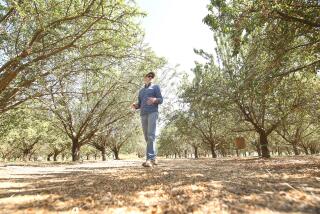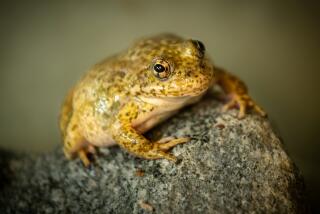Toad Tracking : Recent Rain Saves Rare Amphibians, but Scientist Sees Threat of Extinction
LOS PADRES NATIONAL FOREST — The sun had set two hours earlier. Deep in the woods, miles from the nearest pavement, a stream echoed with the raucous sounds of two common species of tree frogs.
Suddenly a melodious trill was added to the cacophony, like someone whistling and rolling Rs at the same time. It was a sound few have ever heard--the unique mating call of the male arroyo toad.
U.S. Forest Service wildlife biologist Nancy Sandburg, 35, shined her flashlight in the direction of the new notes. Frozen in the circle of her light was the rare olive, yellow and tan amphibian, his throat bulging and pulsating rapidly, alerting any female arroyo toad that he would welcome her company.
If not for the recent rains that brought water to the streams and tributaries of the Santa Ynez River system for the first time in five years, these toads could have vanished from the area forever, Sandburg said as three more male arroyo toads belted out their mating call.
Sandburg is assisting Sam Sweet, 42, a UC Santa Barbara herpetologist and the world’s only arroyo toad expert. He is unraveling many of the mysteries of the stout-bodied, short-legged nocturnal amphibians and hopes to save them from extinction.
He and Sandburg agree that for these tiny creatures--which Sweet feels should be added to the endangered species list--the March rains came as a lifeline.
In the last year and a half, Sweet has hiked 280 miles along river systems throughout the Los Padres National Forest in Santa Barbara and Ventura counties looking for arroyo toad habitats.
Sweet has recorded sighting 180 of the little-known animals in five widely scattered areas of the forest. But he estimates there could be as many as 1,500 adult arroyo toads in Los Padres scattered along stretches of streams.
It is possible, but not certain, that much smaller populations of the toads still survive in three small areas in the Cleveland National Forest in San Diego County and a few in Baja California near Ensenada. These are the only known locations of the toad on Earth.
Even if the 1,500 tally is accurate, it is a far cry from the tens of thousands of toads that once thrived in Southern California, according to Sweet.
“I have studied the arroyo toad 10 years and seen its numbers dramatically decline--as they have been ever since the 1930s with the advent of developments in their former habitats in coastal Southern California, from San Luis Obispo County south into Baja California,” Sweet said.
“The current drought has been particularly worrisome. Without any rain this year it was uncertain whether some of the populations in the Los Padres Forest would have made it,” he said.
Throughout California, the five-year dry spell has taken a deadly toll on wildlife--from devastated salmon runs to shrinking watering holes for deer and other animals.
But for the arroyo toad the drought has been particularly harsh.
When the stream beds that serve as home to the arroyo toads run dry, Sweet said, the amphibians “hunker down and lay low, burrowed 1 to 2 feet deep in sand, coming out only on damp nights looking for insects to eat.”
The toads, which grow to an adult length of about two inches, breed only in water, so the drought took away nearly all of their breeding territory, dramatically reducing the number of young. Since no one knows how long the toad lives, Sweet feared that they could die out before more young were produced.
He is now studying how much the March rains affected that dismal prospect.
Sweet says the arroyo toads, always few in number as toad species go, were found in the drainage systems of Los Angeles, Orange and San Diego counties until developments in the last 60 years wiped out their habitats.
The ideal arroyo toad habitat is found in major drainages with sandy, shallow, cobblestone bars, and shady trees along stream banks--favorite areas for recreation and camping, and ideal locations for dams.
Sweet believes several species of non-native fish introduced into local rivers and streams may be feeding on arroyo toad eggs, tadpoles and the toad itself. Sweet also believes bullfrogs--introduced by frog-leg farmers in the ‘30s and ‘40s--may be feasting on arroyo toads.
“So little is known about the arroyo toad. They are extremely difficult to find. During the day they bury themselves in sand. They come out at night. . . . There are just a handful in any one area. It’s like looking for one stone in 10 million stones,” said Sweet.
“The only time it’s possible to see them is when the male sits in the shallow water trilling for about six weeks during mating season.”
Sweet, editor of the prestigious Journal of Herpetology, a nationally published scientific journal on the study of reptiles and amphibians, is preparing a petition to have the arroyo toad declared an endangered species.
And to make sure the toads don’t go the way of the Dodo bird, the passenger pigeon and so many other wildlife species, Sweet brought 15 arroyo toad tadpoles to his lab on the UC Santa Barbara campus two years ago. Fourteen are now toads and are doing well.
It was the first time arroyo toads had been raised in captivity, Sweet said.
Last year he transported to his lab another 40 tadpoles from a much larger number swimming in five small ponds in the forest. They are now year-old toads.
Sweet believes it isn’t too late to save the arroyo toad.
“By learning everything about the toad’s biology, land use decisions can be made to protect them. By fencing off habitats and streams driven through by off-road vehicles, by removing bullfrogs and exotic fish from arroyo toad habitats, it will help ensure their continuation on earth,” he insists.
As for his lab-raised toads, Sweet finds them important for learning more about the rare amphibian. He hopes to breed arroyo toads for the first time ever in captivity this year or next.
“Of course the lab toads are an insurance measure to prevent them from becoming extinct and as a population that could later be released in the wild,” he said.
“But if existing populations can’t make it, we can hardly expect that by reintroducing the species into the same degraded environment it would fare any better.”
More to Read
Sign up for Essential California
The most important California stories and recommendations in your inbox every morning.
You may occasionally receive promotional content from the Los Angeles Times.










